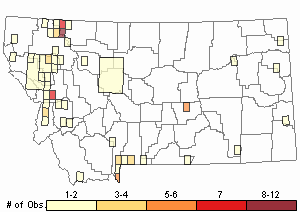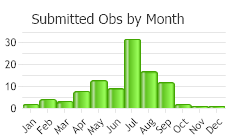View in other NatureServe Network Field Guides
NatureServe
Montana
Utah
Wyoming
Idaho
Wisconsin
British Columbia
South Carolina
Yukon
California
New York
Tufted Gemmabryum Moss - Gemmabryum caespiticium
Other Names:
Tufted Bryum,
Bryum caespiticium
General Description
Plants: Acrocarpous (Vitt 1988). Erect and growing in low turfs or cushions (FNA 2014), occasionally intermingled with other moss species, green above and brown below (Lawton 1971). Stems 1-30 mm (FNA 2014), sometimes gemmiform, frequently branched, and typically strongly rhizoidal at the base (Lawton 1971).
Leaves: Appressed and overlapping (FNA 2014), the upper larger leaves creating a rosette, 0.6-1 mm In width (Lawton 1971), 0.5-3 mm in length, egg- to lance-shaped, moderately or sometimes faintly cupped; base not extending down the stem; margins flat to tightly rolled back and downward, with 1 or 2 series of somewhat long, thick-walled cells creating a faint to moderate border; apex occasionally becoming transparent over time (FNA 2014); costa red at the base (Crum & Anderson et al. 1981), extending beyond the apex, forming a strong, short to long, smooth or seldom finely-toothed, brownish to transparent awn (FNA 2014).
Leaf Cells: Alar cells of fertile stem leaves square and swollen; lower laminal cells square to quadrangular,1-2:1 (longer adjacent to the costa), the region clearly delimited; middle and upper cells 6-sided, 3-6:1; margins of 1 cell-layer (FNA 2014).
Phenology
Fruit ripening spring to summer (FNA 2014).
Diagnostic Characteristics
This species can be recognized by its habitation of disturbed areas, dioicous condition, and perfect peristome. Bryum lisae var. cuspidatum, which also inhabits disturbed sites, has broader leaf points, shorter upper cells, and a rougher appearance (Crum & Anderson et al. 1981).
Range Comments
North American Range
AK to NL and NS, throughout the United States except LA to SC and FL; Mexico (FNA 2014). Known in Montana from Carbon, Deer Lodge, Fallon, Flathead, Gallatin, Glacier, Granite, Lake, Lewis and Clark, Lincoln, Meagher, Missoula, Park, Powder River, Ravalli, and Sanders Counties (Elliott 2016).
Observations in Montana Natural Heritage Program Database
Number of Observations: 121
(Click on the following maps and charts to see full sized version)
Map Help and Descriptions
Relative Density

Recency



 (Observations spanning multiple months or years are excluded from time charts)
(Observations spanning multiple months or years are excluded from time charts)
Habitat
Decayed wood, rock, disrupted soil and habitats. Elevation: 3-13,120 feet (FNA 2014).
Reproductive Characteristics
Dioicous. Seta 2-3 cm tall (Lawton 1971). Capsule pear-shaped and drooping (FNA 2014), the urn 3-4 mm in length (Lawton 1971), the neck slender and slowly narrowing to the seta; peristome perfect (Crum & Anderson et al. 1981), the teeth yellow with brown tones, minutely papillose (Lawton 1971); endostome divisions varying from light tan (seldom light yellow) to russet or brown (FNA 2014).
Specialized vegetative reproduction by red, globose tubers growing on rhizoids, and brood branchlets in the upper leaf/stem junctions (FNA 2014).
Stewardship Responsibility
References
- Literature Cited AboveLegend:
 View Online Publication
View Online Publication Crum, H.A. and L.E. Anderson. 1981. Mosses of Eastern North America. 2 volumes. Columbia University Press, New York. 1328 pp.
Crum, H.A. and L.E. Anderson. 1981. Mosses of Eastern North America. 2 volumes. Columbia University Press, New York. 1328 pp. Elliott, J.C. and A.K. Pipp. 2018. A Checklist of Montana Mosses (1880-2018). Updated 3 January, 2020. Montana Natural Heritage Program, Helena, Montana. 73 pp.
Elliott, J.C. and A.K. Pipp. 2018. A Checklist of Montana Mosses (1880-2018). Updated 3 January, 2020. Montana Natural Heritage Program, Helena, Montana. 73 pp. Flora of North America Editorial Committee, eds. 2014. Flora of North America North of Mexico. Volume 28. Bryophytes: Mosses, Part 2. Oxford University Press, Inc., NY. xxi + 702 pp.
Flora of North America Editorial Committee, eds. 2014. Flora of North America North of Mexico. Volume 28. Bryophytes: Mosses, Part 2. Oxford University Press, Inc., NY. xxi + 702 pp. Lawton, E. 1971. Moss Flora of the Pacific Northwest. Hattori Botanical Laboratory. Japan: Yamabuki-cho, Shinjuku-ku, Tokyo. 362 pages plus appendices.
Lawton, E. 1971. Moss Flora of the Pacific Northwest. Hattori Botanical Laboratory. Japan: Yamabuki-cho, Shinjuku-ku, Tokyo. 362 pages plus appendices. Vitt, D. J. Marsh, and R. Bovey. 1988. Mosses, Lichens & Ferns of Northwest North America. Seattle, WA: University of Washington Press. 296 p.
Vitt, D. J. Marsh, and R. Bovey. 1988. Mosses, Lichens & Ferns of Northwest North America. Seattle, WA: University of Washington Press. 296 p.
- Additional ReferencesLegend:
 View Online Publication
View Online Publication
Do you know of a citation we're missing? Aho, Ken Andrew. 2006. Alpine and Cliff Ecosystems in the North-Central Rocky Mountains. Ph.D. Dissertation. Bozeman, Montana: Montana State University. 343 p.
Aho, Ken Andrew. 2006. Alpine and Cliff Ecosystems in the North-Central Rocky Mountains. Ph.D. Dissertation. Bozeman, Montana: Montana State University. 343 p. Elliot, J. C. 1993. Second checklist of Montana mosses. Unpublished report. U.S. Forest Service, Region 1. Missoula, MT. 45 pp.
Elliot, J. C. 1993. Second checklist of Montana mosses. Unpublished report. U.S. Forest Service, Region 1. Missoula, MT. 45 pp. Flowers, S. 1973. Mosses: Utah and the West. Brigham Young University, Provo, Utah. 567 p.
Flowers, S. 1973. Mosses: Utah and the West. Brigham Young University, Provo, Utah. 567 p. Lawton, E. 1971. Keys for the Identification of the Mosses on the Pacific Northwest. Reprinted from 'Moss Flora of the Pacific Northwest'. Published as Supplement No. 2 of the Journal of the Hattori Botanical Laboratory. Nichinan, Miyazaki, Japan. 66 pp.
Lawton, E. 1971. Keys for the Identification of the Mosses on the Pacific Northwest. Reprinted from 'Moss Flora of the Pacific Northwest'. Published as Supplement No. 2 of the Journal of the Hattori Botanical Laboratory. Nichinan, Miyazaki, Japan. 66 pp. Malcolm, B., N. Malcolm, J. Shevock, and D. Norris. 2009. California Mosses. Nelson, New Zealand: Micro-Optics Press. 430 pp.
Malcolm, B., N. Malcolm, J. Shevock, and D. Norris. 2009. California Mosses. Nelson, New Zealand: Micro-Optics Press. 430 pp. Smith, A.J.E. 1980. The Moss Flora of Britain and Ireland. Cambridge University Press, Cambridge. 705 pp.
Smith, A.J.E. 1980. The Moss Flora of Britain and Ireland. Cambridge University Press, Cambridge. 705 pp.
- Web Search Engines for Articles on "Tufted Gemmabryum Moss"





